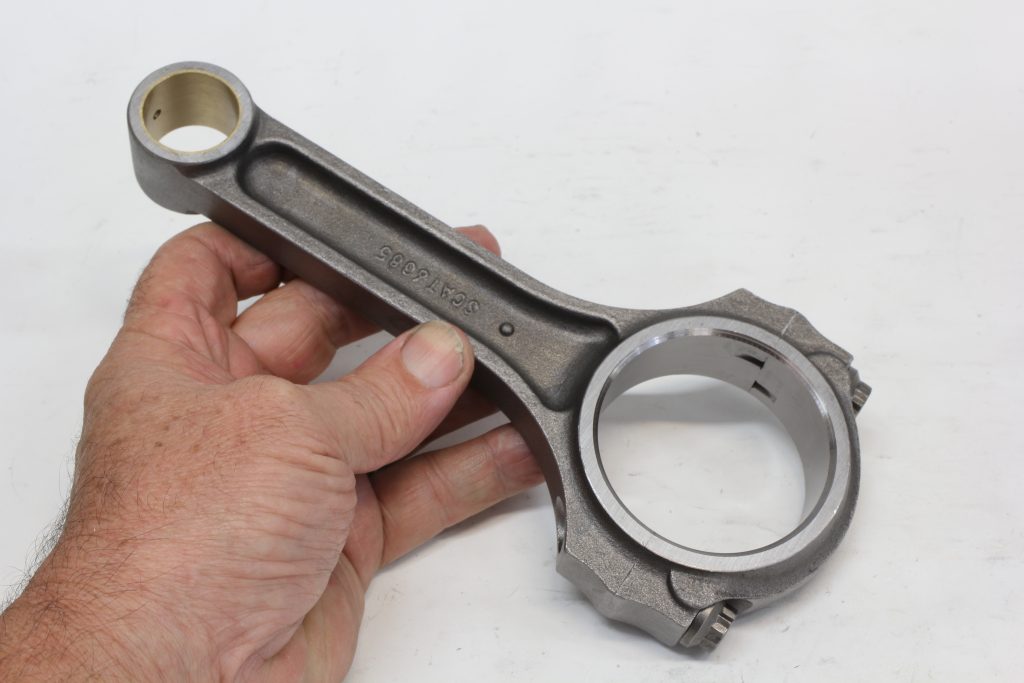I’m building a 383ci small block Chevy that will use a good set of forged aluminum pistons and I’m considering the difference between rebuilding my stock 5.7 inch rods with ARP bolts or going with either an Eagle or SCAT I-beam connecting rod. I think I can have the stock 5.7 inch rods rebuilt by my local shop for less money than either the Eagle or SCAT rods, but maybe there’s something I’m missing? I would appreciate your input.
J.D.
The short, simple answer to your question is that rebuilding your stock connecting rods will probably cost less but there are considerably more details to this answer than just less money. Let’s look into this.
Below is a representative cost to rebuild a stock set of small block 5.7 inch connecting rods. Remember, your prices may vary.
Estimated Connecting Rod Rebuild Rebuild Cost (Feb. 2023)
- Magnaflux inspect – $40
- Resize rods / install bolts – $180
- ARP 383 stroker rod bolts (PN ARP-134-6027) – $80
Total $300
Conversely, new SCAT 4340 I-beam connecting rods currently sell for around $350. (We used part number SCA-ICR5700 for this comparison.)
Engine Connecting Rod Material Comparison Chart
| Material | Yield Strength | Tensile Strength |
|---|---|---|
| 1038 Mild Steel | 70,300 psi | 82,700 psi |
| 1053 Steel | 84,000 psi | 144,000 psi |
| 4340 High Carbon Steel | 68,200 psi | 108,000 psi |
| These numbers are before heat treating. SCAT undergoes a multi-stage heat treatment process that will raise these numbers. | ||
The above chart lists yield and tensile strength for both a stock rod using 1038 steel and 1053, and finally 4340 high carbon steel which is the alloy steel that most aftermarket rods like the Eagle or SCAT rods are forged from. What’s not listed here is an important factor of fatigue strength. This is the number of cycles of maximum stress a material can withstand before breaking. Generally while a 4340 steel might not exhibit the highest tensile strength, it offers far superior fatigue strength.
So ultimately, you are purchasing much stronger connecting rods that are more evenly matched than production rods in terms of both center-to-center length as well as in weight—often within a couple of grams.
So with the superiority of these aftermarket rods in both strength and production tolerances and with a similar, if not better, ARP connecting rod bolts, it would seem when we compare the overall price that the rather small savings you could gain by rebuilding the stock rods easily justifies the added expense to purchase the better aftermarket rods.
We chose to look at specifics using the SCAT 5.7 inch Pro Stock I-beam rod, but rods from Eagle and other companies with similar products will probably be very similar.
If all you intend to do is cruise around using this 383 engine to do mild duty on the streets and highways, then the stock rods will almost certainly do the job. But people who build 383s are more often going to take their engine to the drag strip, pushing it harder than 5,500 to 6,000 rpm, or actually running it in some other competition situation. If so, then the added insurance of the better aftermarket 4340 steel alloy rods seems like a very wise decision.

Engine Speed & Its Impact on Connecting Rods
One point that is often not discussed when it comes to connecting rod durability is engine speed. Most manufacturers rate their connecting rods by horsepower rather than rpm. This is because it requires too much time and space to explain the difference.
Horsepower, if we define it as cylinder pressure, does not kill connecting rods. High engine speed is what kills rods and here’s why.
All connecting rods are designed to handle the high cylinder pressure loads that tend to compress the rod as cylinder pressure pushes the piston and rod assembly downward. The far more destructive issue is when the connecting rod changes direction at the top of its stroke. As the piston changes direction downward on the exhaust stroke, this creates a tensile or pulling force on the cap and the rod bolts. This elongation grows in severity as rpm increases. Oddly, a rod that can survive forever at 6,000 rpm might fail dramatically when stressed for only a few moments at 7,000 rpm. This is because the tensile or pulling force on the rod increases dramatically with even a small increase in rpm.
So if your plans include spinning your 383 at over 6,000 rpm, this is another good reason that will more than justify the investment in a stronger and more fatigue-resistant 4340 aftermarket steel connecting rod. This was probably a much longer answer than you likely expected to get but the facts make for convincing arguments.

Of course the stock rods may not need to be rebuilt. Reusing the stock bolts and nuts is always a possibility too. Careful inspection may reveal them to be OK.
Measuring the big and small ends and a magnaflux test may be your only expense.
Using the stock 350 rod brings a possible interference or clearance problem with the cam lobes on certain cylinders while the Scat rod or Eagle rod would be designed to remedy that issue.
I personally bought an Eagle rotating assembly for my 383 with the thought being all the parts would be weight matched and would work together. You also need to factor in your time to deal with the machine shop. Check out my 383 El Camino at Kens Hobby on YouTube.
Why would you go through the effort of adding a stroker crank and clearance it to throw back a trash rod. Get a 4340 h-beam 6.0 and call it a day.
No sense in opening up an engine to put trash rods in when the upgrade cost for brand new rods is maybe a few hundred more. Peace of mind is invaluable.